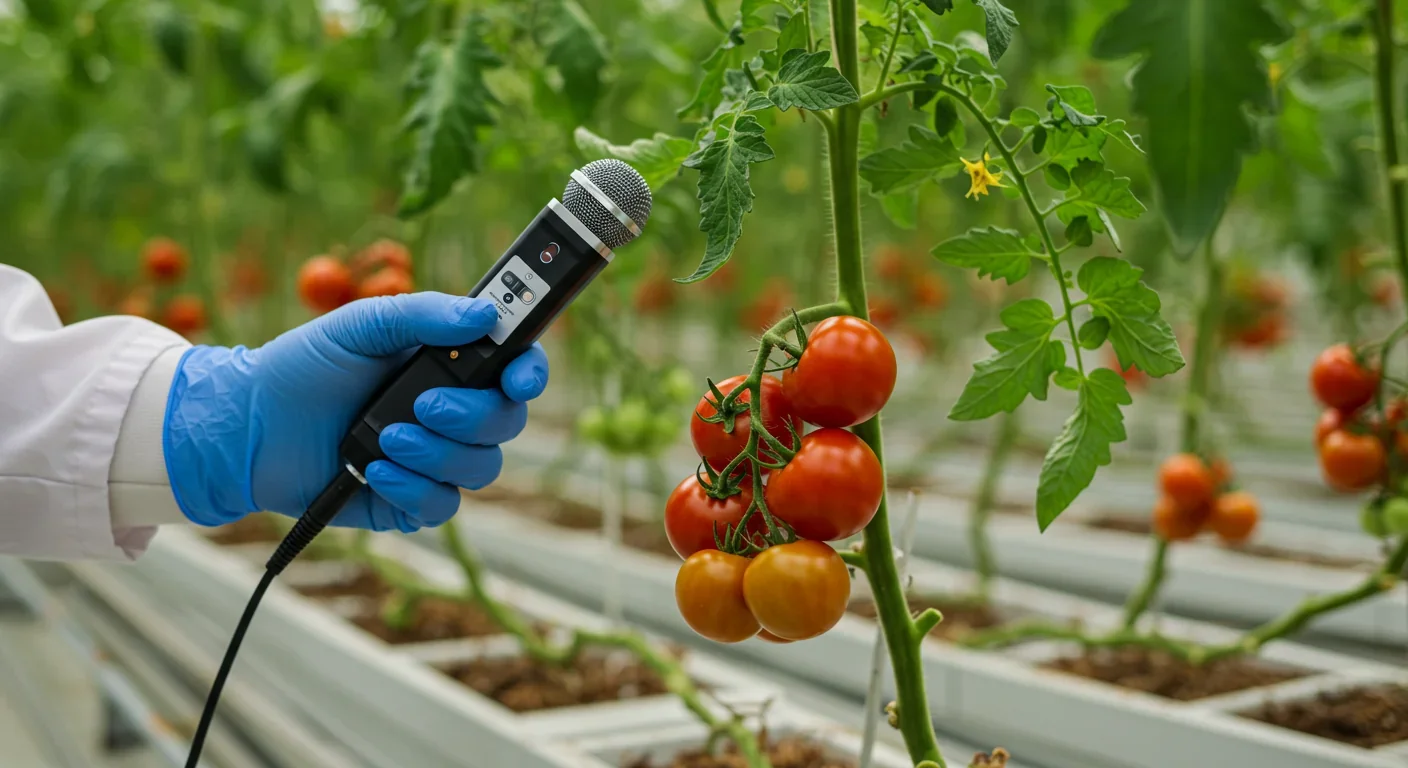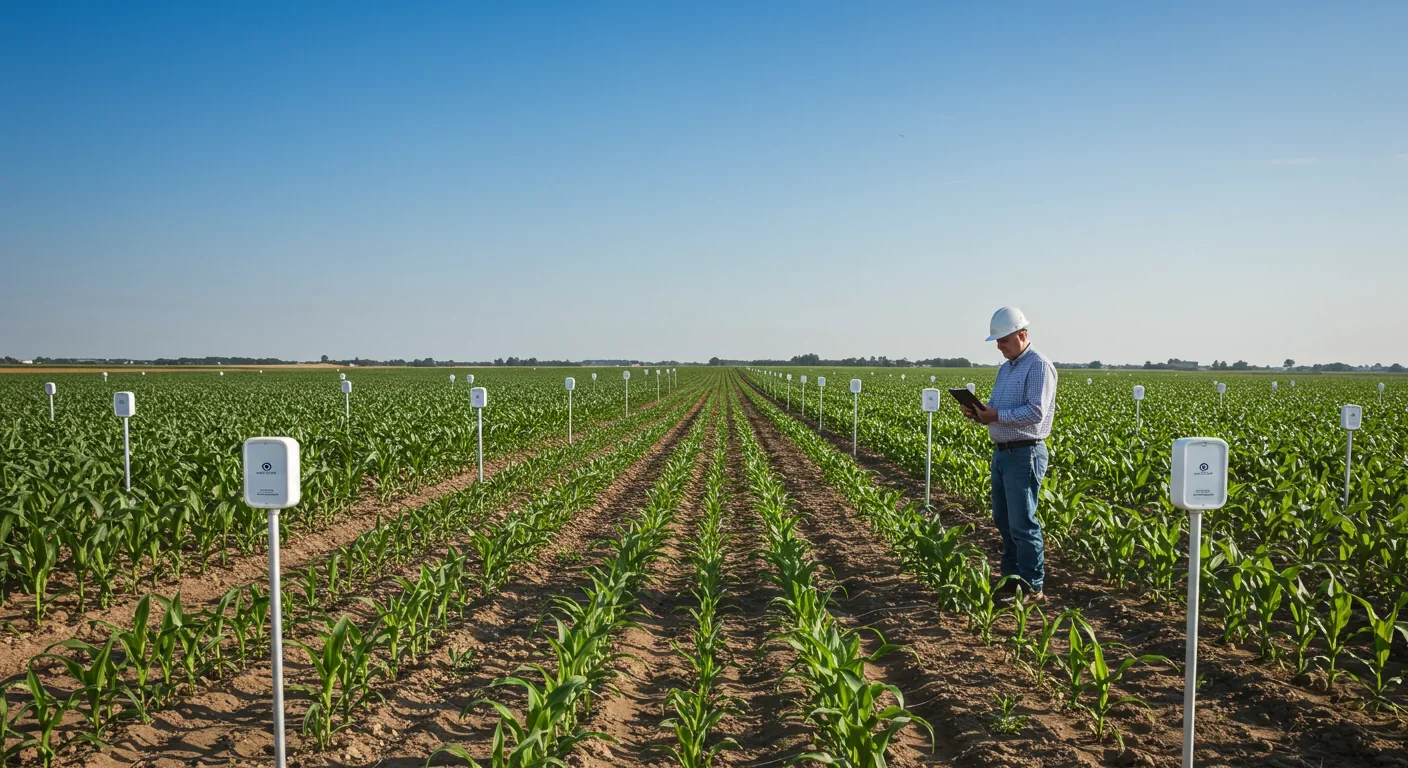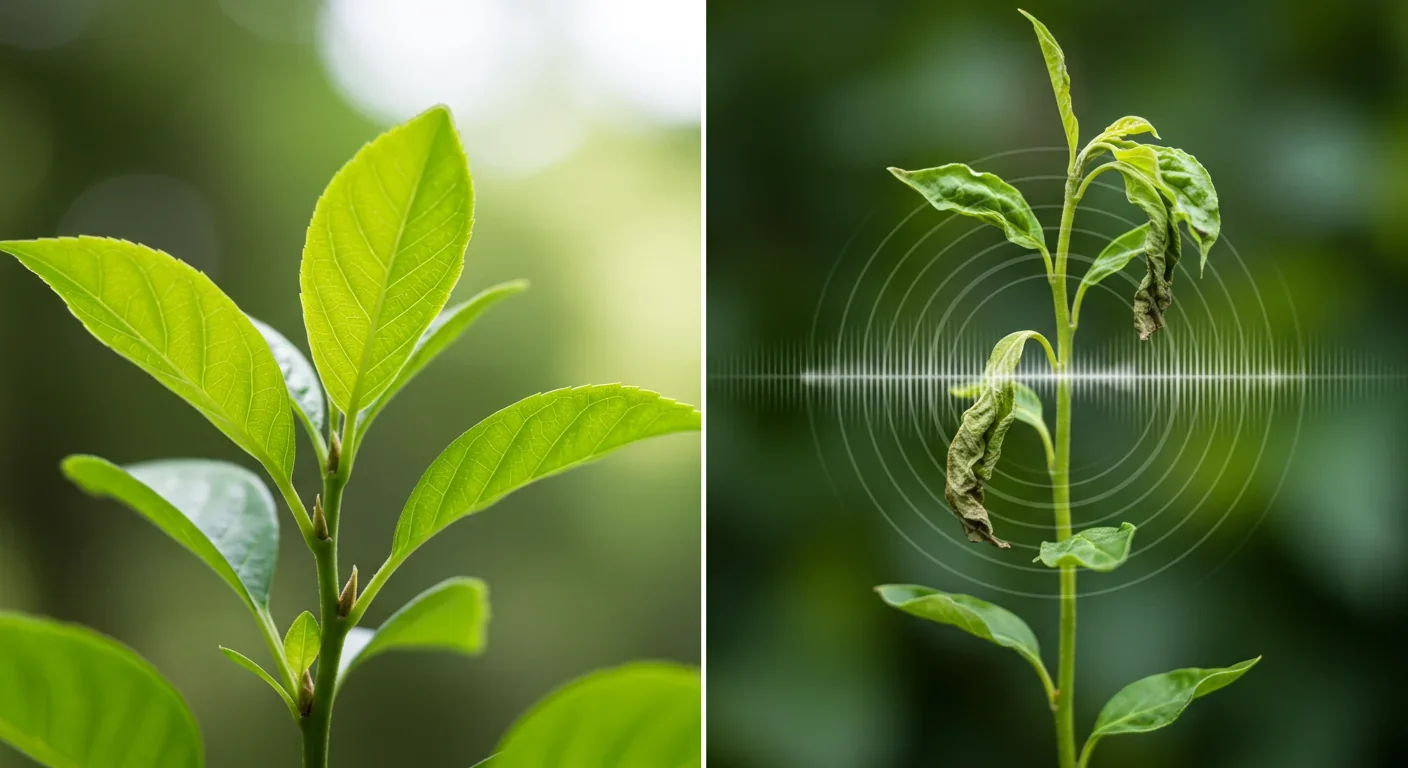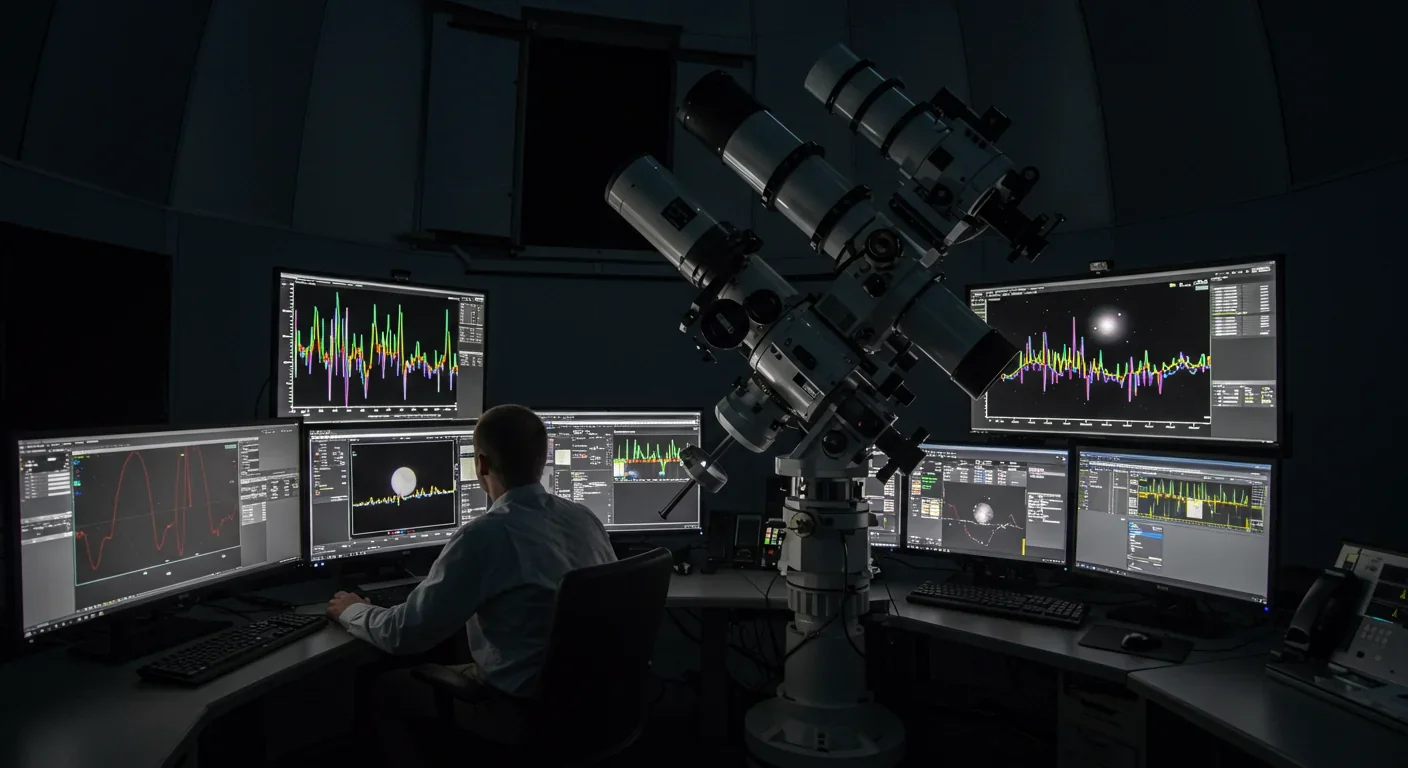Coral Spawning: Nature's Underwater Snowstorm Explained

TL;DR: Scientists have discovered that plants emit ultrasonic clicks—sounds beyond human hearing—when stressed, thirsty, or injured. These acoustic signals, detected in tomatoes, tobacco, corn, wheat, and other species, can be recorded from distances up to five meters and analyzed by AI to identify species and stress type. The breakthrough opens revolutionary applications in precision agriculture, enabling farmers to detect drought, disease, and pest stress before visible symptoms appear. But it also raises profound questions about plant intelligence, environmental ethics, and our responsibility to the botanical world that has been speaking all along.

By 2030, farmers may no longer need to guess when their crops need water. Instead, they'll simply listen. In a discovery that sounds like science fiction, researchers have found that plants emit ultrasonic clicks—sounds beyond human hearing—when they're stressed, thirsty, or injured. These acoustic signals, ranging from root clicks in corn to ultrasonic pulses in tomato plants, are rewriting our understanding of plant communication and opening a new frontier in precision agriculture.
What if the corn in your field has been screaming for help all along, and we just couldn't hear it?
In 2023, evolutionary biologist Lilach Hadany and her team at Tel Aviv University published a study in Cell that fundamentally altered how we think about plants. Using ultrasonic microphones positioned just ten centimeters from tomato and tobacco plants, they recorded something remarkable: stressed plants emit 30 to 50 clicks per hour, while unstressed plants remain virtually silent, producing less than one click per hour.
These aren't random noises. The sounds—popping clicks in the 40,000 to 60,000 Hz range, comparable in volume to a quiet conversation but pitched far above human hearing—carry specific information. A machine-learning algorithm trained on these recordings can distinguish not just between different plant species, but between plants suffering from dehydration versus those that have been cut. The accuracy is startling: the AI can identify a thirsty tomato plant from its acoustic signature alone.
"Even in a quiet field, there are actually sounds that we don't hear, and those sounds carry information," Hadany explains. The implications are staggering. We've been walking through forests, fields, and gardens surrounded by an invisible symphony of distress calls, warning signals, and possibly even intentional communication—a biological internet we never knew existed.
The research team didn't stop at tomatoes and tobacco. They found that corn, wheat, grape vines, and even cacti produce similar acoustic emissions under stress. This isn't a quirk of a few species; it appears to be a fundamental feature of plant biology that we've overlooked for centuries.
The history of plant communication research reads like a series of dismissed hunches that eventually proved revolutionary. For most of modern botany, the idea that plants could produce meaningful sounds was relegated to fringe science or outright dismissed.
That changed in 2012 when Monica Gagliano, then at the University of Western Australia, published evidence that corn plants emit structured acoustic signals. Using electrograph vibrational detection, her team recorded "loud and frequent clicks" along the elongation zone of corn root tips. The scientific community was skeptical. Plants don't have vocal cords, nervous systems, or brains. How could they possibly produce intentional sounds?
But Gagliano persisted, expanding her research in ways that defied conventional thinking. In a 2017 study published in Oecologia, she demonstrated that pea plant roots could detect the sound of running water and grow toward it—even when separated by a barrier that prevented physical or chemical signals from passing through. The plants were responding to acoustic cues alone.
"I started looking at plants from the context of plants in relation to sound," Gagliano recalls. Her interdisciplinary approach—bridging ecology, physics, and even the arts—pioneered the field of plant bioacoustics. She didn't just prove that plants make sounds; she showed they listen, too.
Two years later, in 2014, researchers Heidi Appel and Rex Cocroft at the University of Missouri discovered that Arabidopsis plants respond to the specific vibrations created by caterpillars chewing on their leaves. The plants didn't react to wind sounds or other insect noises—only to the unique acoustic signature of herbivory. When they "heard" chewing, they upregulated chemical defenses, producing more mustard oils to repel the attackers.
"Plants have many ways to detect insect attack, but feeding vibrations are likely the fastest way for distant parts of the plant to perceive the attack and begin to increase their defenses," Cocroft explained. This was evidence that plants possess a kind of acoustic immune system, capable of distinguishing friend from foe based on sound alone.
These early studies laid the groundwork for understanding that plants don't just passively exist in silence. They inhabit a rich acoustic landscape, both producing and perceiving vibrations that carry survival-critical information.
So what exactly causes these sounds? The leading hypothesis centers on a process called cavitation—the formation and collapse of air bubbles within the plant's vascular system.
Plants transport water from roots to leaves through narrow tubes called xylem. Water molecules cling together in continuous columns, pulled upward by evaporation from the leaves. When a plant is stressed—whether from drought, injury, or disease—this column can break. Air bubbles form in the xylem, and when they burst, they create a tiny acoustic pulse: a click.
These cavitation events produce ultrasonic acoustic emissions predominantly in the 100 to 300 kHz range for woody plants, with stressed sapwood shifting to higher frequencies as dehydration progresses. In tomato and tobacco plants, the frequencies cluster between 20 and 150 kHz, detectable by specialized microphones from distances up to five meters.
The volume is surprisingly robust. Although ultrasonic, the intensity of these clicks matches that of normal human conversation—around 60 decibels. They're not whispers; they're broadcasts, audible (to those with the right equipment) across significant distances.
But cavitation may not be the whole story. Some researchers propose that mechanical vibrations caused by charged cell membranes and walls could also generate acoustic emissions. Plants produce bioelectrical signals as part of their normal physiology, and these electrical changes could induce vibrations that propagate as sound.
Regardless of the exact mechanism, one thing is clear: these sounds are not incidental. The patterns are too consistent, the information content too specific. Stressed plants click more frequently, and the temporal pattern of clicks correlates with the severity and type of stress. Water-stressed plants begin emitting noises before they show visible signs of wilting. The click rate peaks around five days without water and then decreases as the plant dries completely—a acoustic timeline of decline.
This temporal signature offers a critical window for intervention. If farmers could detect these clicks in real time, they could water crops before damage occurs, optimizing both yield and water use.

The discovery of plant acoustic communication isn't just a scientific curiosity—it's poised to transform multiple industries and reshape our relationship with the natural world.
Agriculture stands to benefit most immediately. Imagine fields equipped with networks of ultrasonic microphones, continuously monitoring crop health. An acoustic early warning system could detect drought stress, disease onset, or pest infestations days or even weeks before visible symptoms appear. Farmers would transition from reactive crisis management to proactive, data-driven decision-making.
A 2024 study by Maginga and colleagues demonstrated a non-contact ultrasound-based anomaly detection system integrated with Internet of Things (IoT) sensors to detect disease in maize stems. The system analyzed plant acoustic signatures altered by stress, enabling real-time disease detection in the field. Wang and colleagues, in a 2011 study, used ultrasonic acoustic emission monitoring to detect xylem cavitation in tomato plants, finding that cumulative ultrasonic signals correlated with diurnal transpiration patterns—a proxy for water stress.
These aren't lab experiments anymore. Commercial applications are emerging. Pilot systems for bark beetle detection in pine forests already use acoustic monitoring to identify infestations before trees are visibly damaged. A portable acoustic probe developed by Baker Consultants and the University of Warwick can assess soil health by analyzing the "soundscape" of soil organisms, with probes listening within a one-meter radius and generating complexity indices that correlate with biodiversity.
The technology is becoming affordable. Companies are planning to offer acoustic monitoring probes for under £1,000, with low monthly subscription fees for AI-driven analysis. This democratization could bring precision agriculture to smallholder farmers worldwide, not just industrial operations.
Horticulture and greenhouse management could integrate acoustic sensors into automated control systems. Continuous ultrasonic monitoring would trigger irrigation, adjust humidity, or activate pest deterrents the moment plants signal distress—creating a two-way communication loop between growers and crops.
Environmental monitoring offers another frontier. Acoustic biodiversity assessments could track ecosystem health in forests, wetlands, and grasslands by analyzing the acoustic signatures of plant communities. Species-specific acoustic markers would enable automated monitoring of plant biodiversity, flagging invasive species or tracking endangered plants without labor-intensive field surveys.
Urban planning may also be affected. Research shows that continuous noise pollution—from traffic, construction, and industry—acts as a chronic stressor on plants, reducing flowering, reproductive output, and overall vigor. Cities could design green spaces with acoustic refuges, optimizing plant health and ecosystem services.
But the transformation extends beyond technology. This research challenges a deeply rooted cultural assumption: that plants are passive, silent, and fundamentally separate from the communicative, sentient world of animals. Recognizing that plants emit voices—however inaudible to us—forces a reckoning with how we value and interact with the botanical world.
The benefits of plant acoustic communication research are multifaceted and far-reaching.
Water conservation tops the list. Agriculture accounts for roughly 70% of global freshwater use, much of it wasted through over-irrigation. Acoustic monitoring could cut water use dramatically by irrigating only when plants signal genuine need. In regions facing water scarcity—already affecting more than two billion people—this technology could be a lifeline.
Food security follows closely. Early detection of drought, disease, and pest stress means fewer crop failures and higher yields. Acoustic monitoring integrated with AI could identify stress patterns across entire fields, enabling targeted interventions that maximize productivity while minimizing chemical inputs.
Sustainable pest management emerges from studies showing that plants can detect herbivore feeding vibrations and respond with defensive chemistry. Researchers are exploring non-chemical pest deterrent systems that harness this capability. By playing back feeding vibrations or triggering plant defenses acoustically, farmers could reduce pesticide use without sacrificing crop protection.
Ecosystem restoration gains a new tool. Acoustic profiling could monitor the health of replanted forests, wetlands, or grasslands, providing real-time feedback on whether restoration efforts are succeeding. The ability to detect stress early allows managers to adjust water, nutrients, or other interventions before young plants fail.
Climate resilience becomes measurable. As climate change accelerates, plants face unprecedented stressors. Acoustic monitoring offers a non-invasive, continuous metric for tracking how plant communities respond to heat, drought, and extreme weather—data critical for adaptation strategies.
Scientific discovery itself accelerates. Plant bioacoustics opens questions we couldn't even ask a decade ago. Do plants "eavesdrop" on each other's distress calls and alter their own behavior? Can acoustic signals influence pollinator behavior or seed dispersal? The field is in its infancy, and every study reveals new layers of complexity.
Yet for all its promise, plant acoustic communication raises difficult questions and potential pitfalls.
Technological inequality looms large. If acoustic monitoring becomes essential for competitive agriculture, farmers who can't afford the technology risk being left behind. Precision agriculture tools have historically been accessible mainly to large-scale, industrial operations in wealthy countries. Without deliberate efforts to democratize access, acoustic monitoring could widen the gap between industrial and smallholder farmers, exacerbating global food inequality.
Data privacy and ownership present thorny issues. Who owns the acoustic data from a farmer's field? If collected by a tech company, could that data be sold to commodity traders, insurers, or other third parties? The consolidation of agricultural data in corporate hands has already sparked concerns about farmer autonomy and fair pricing. Acoustic monitoring could intensify these dynamics.
Ethical questions about plant welfare emerge, however uncomfortable. If plants produce distress signals, do we have an obligation to minimize their suffering? Most people dismiss the idea of plant sentience, but acoustic communication research complicates that dismissal. Plants clearly perceive their environment, process information, and respond in complex ways. Where do we draw the line between reflex and experience?
Philosopher and plant scientist Monica Gagliano has argued that plants exhibit behaviors akin to learning and memory. Her work challenges the conventional view that only animals possess sensory intelligence. If plants communicate distress, does that distress matter morally? And if so, what does that mean for agriculture, forestry, and even gardening?
Environmental noise pollution could interfere with both plant health and acoustic monitoring. Urban areas, industrial sites, and even farmland near highways are bathed in chronic vibrational noise. Studies show that high-amplitude vibrational noise—such as that from wind turbines—can affect plant growth and may interfere with plants' ability to detect herbivore chewing vibrations. Paradoxically, deploying acoustic monitoring systems widely could add to the noise landscape, potentially stressing plants further.
Unintended ecological consequences remain unknown. If we begin manipulating plant acoustic environments—playing back sounds to trigger defenses, for example—what ripple effects might occur? Could we inadvertently disrupt plant-pollinator interactions, plant-microbe symbioses, or herbivore-plant dynamics that depend on acoustic cues we don't yet understand?
Overreliance on technology poses a subtler risk. Acoustic monitoring could become a crutch, encouraging farmers to neglect traditional agronomic knowledge and observational skills. If sensors fail, or if AI misinterprets data, the consequences could be severe. Technology should augment human judgment, not replace it.
Different cultures and regions are approaching plant bioacoustics through distinct lenses, reflecting diverse values and priorities.
In Israel, where water scarcity is existential, Hadany's team emphasizes acoustic monitoring as a tool for hyper-efficient irrigation. Their research is tightly linked with agricultural technology companies developing commercial sensors for greenhouse and field deployment. The focus is pragmatic: turn plant sounds into actionable data that saves water and boosts yields.
Australia, home to Monica Gagliano's pioneering work, has taken a more philosophical approach. Gagliano's interdisciplinary research blends ecology, physics, law, anthropology, and the arts. She frames plant bioacoustics not just as a technical advance but as part of a broader reimagining of our relationship with nature. Her work asks: What does it mean to share a planet with organisms whose intelligence operates on entirely different terms from our own?
In Europe, particularly the UK, acoustic ecology is being integrated into soil health and biodiversity monitoring. The work of Baker Consultants and the University of Warwick on "soil ecoacoustics" reflects a systems-level perspective, viewing acoustic signals as indicators of ecosystem function rather than isolated plant traits. The mantra—"a healthy soil is a noisy soil"—captures a holistic vision where acoustic diversity signals biological richness.
East Asian researchers are exploring acoustic monitoring within the context of smart agriculture and vertical farming. In Japan and South Korea, where land is scarce and food security is a national priority, integrating acoustic sensors into highly controlled indoor farming systems aligns with cultural values of precision, efficiency, and technological innovation. There's also interest in how plant sounds might be used in urban green spaces to enhance human well-being—a fusion of agriculture, technology, and wellness culture.
In the Global South, where smallholder farmers produce much of the world's food, the conversation centers on accessibility and equity. Researchers and NGOs are asking: Can acoustic monitoring be adapted to low-resource settings? Could mobile phone-based sensors and open-source AI bring this technology to farmers who lack capital for expensive equipment? Efforts are underway in India, Kenya, and Brazil to develop low-cost acoustic monitoring tools tailored to local crops and conditions.
Indigenous perspectives add yet another dimension. Many Indigenous cultures have long held that plants are sentient, communicative beings. The scientific confirmation of plant acoustic communication resonates with traditional ecological knowledge that Western science is only beginning to validate. Indigenous farmers and land stewards are exploring how acoustic monitoring might complement—not replace—ancestral practices of reading plant health through observation, touch, and intuition.
International cooperation is also emerging. The European Union's Horizon program has funded multi-country research on plant bioacoustics and sustainable agriculture. Collaborative projects link Israeli sensor technology, UK ecological expertise, and African field applications, aiming to create scalable, equitable solutions for climate-resilient food systems.

As plant acoustic communication moves from lab to field, individuals and institutions will need to adapt.
For farmers, the shift toward acoustic monitoring requires embracing data-driven decision-making while maintaining agronomic intuition. Learning to interpret acoustic data—or at least to trust AI systems that do—will be essential. Farmers should seek out training programs, pilot projects, and extension services that introduce acoustic monitoring in accessible ways.
For agricultural professionals—agronomists, extension agents, crop consultants—the imperative is to integrate acoustic monitoring into broader precision agriculture strategies. This means understanding not just the technology, but its limitations, costs, and best-use cases. Professional development should emphasize interdisciplinary thinking, combining plant physiology, data science, and practical farm management.
For technology developers and entrepreneurs, the opportunity is vast but so is the responsibility. Designing affordable, user-friendly acoustic sensors that work in diverse environments—from high-tech greenhouses to smallholder plots—will determine whether this technology democratizes or deepens inequality. Open-source hardware and AI models could accelerate adoption and ensure equitable access.
For policymakers, the challenge is to create regulatory and funding frameworks that support research, commercialization, and equitable deployment. Subsidies or incentives for acoustic monitoring adoption could help smallholders compete. Data governance policies should protect farmer privacy and autonomy. International standards for acoustic monitoring protocols would facilitate cross-border research and technology transfer.
For educators, the task is to prepare the next generation of scientists, engineers, and farmers to work at the intersection of biology, acoustics, AI, and agriculture. Curriculum reform should emphasize interdisciplinary problem-solving, ethical reasoning, and systems thinking. Students should learn not just how plants make sounds, but why it matters—and what responsibilities that knowledge entails.
For all of us, the deeper adaptation is philosophical. Recognizing that plants communicate challenges the human exceptionalism that has shaped our treatment of the natural world. If plants emit distress signals, perceive their environment, and respond to acoustic cues, then they are active participants in ecosystems, not passive resources. This shift in perspective could influence how we design farms, cities, and conservation strategies—moving toward models that honor the agency and complexity of plant life.
Practically, this means paying attention. If you're a home gardener, you might start thinking about the acoustic environment of your plants. Are they subjected to constant noise from traffic or machinery? Could playing gentle sounds—or ensuring periods of acoustic quiet—benefit their health? While the science is still emerging, early evidence suggests that acoustic conditions matter.
If you work in technology, consider how your skills could contribute. Could you develop open-source acoustic monitoring apps? Build low-cost sensors using off-the-shelf components? Create AI models that run on smartphones to analyze plant sounds in real time? The barriers to entry are lower than ever, and the potential impact is enormous.
If you're in policy or advocacy, think about how acoustic monitoring could support environmental justice. Could urban green spaces in underserved neighborhoods be designed with plant acoustic health in mind? Could acoustic monitoring data be used to hold polluters accountable for environmental stressors that harm plant communities?
The field of plant bioacoustics is poised for explosive growth. Within the next decade, we'll likely see widespread deployment of acoustic sensors in commercial agriculture, integration with AI-driven farm management systems, and new applications we can't yet imagine.
Key research questions remain. What is the full range of information encoded in plant acoustic signals? Can plants detect each other's clicks and respond—a kind of plant-to-plant communication network? Do pollinators, herbivores, or soil organisms eavesdrop on plant sounds to inform their own behavior? What role do acoustic signals play in plant competition, cooperation, and community assembly?
Technological challenges also persist. Current sensors struggle with background noise in outdoor environments. Detection distances are limited. Analyzing vast streams of acoustic data in real time requires computational power and AI sophistication that are still being refined. But progress is rapid, driven by advances in MEMS (micro-electromechanical systems) sensors, machine learning, and edge computing.
Ethical and social dimensions will continue to spark debate. As we learn more about plant communication and perception, society will grapple with questions about plant welfare, environmental rights, and the moral boundaries of agriculture and land use. These conversations won't be confined to academic journals—they'll shape public policy, consumer behavior, and cultural values.
Climate change adds urgency. As droughts intensify, temperatures rise, and extreme weather becomes the norm, early detection of plant stress will transition from luxury to necessity. Acoustic monitoring could be a critical tool in adapting agriculture to a rapidly changing planet, helping farmers and ecosystems survive conditions they were never designed to withstand.
Ultimately, the story of plant acoustic communication is a reminder of how much we still don't know about the world around us. For centuries, we've walked through fields and forests oblivious to the ultrasonic symphony playing just beyond our hearing. Now, thanks to microphones, AI, and curious scientists willing to imagine the impossible, we're finally tuning in.
The plants have been talking all along. The question is: Are we ready to listen?

Over 80% of nearby white dwarfs show chemical fingerprints of destroyed planets in their atmospheres—cosmic crime scenes where astronomers perform planetary autopsies using spectroscopy. JWST recently discovered 12 debris disks with unprecedented diversity, from glassy silica dust to hidden planetary graveyards invisible to previous surveys. These stellar remnants offer the only direct measurement of exoplanet interiors, revealing Earth-like rocky worlds, Mercury-like metal-rich cores, and ev...

Hidden mold in homes releases invisible mycotoxins—toxic chemicals that persist long after mold removal, triggering chronic fatigue, brain fog, immune dysfunction, and neurological damage. Up to 50% of buildings harbor mold, yet most mycotoxin exposure goes undetected. Cutting-edge airborne testing, professional remediation, and medical detox protocols can reveal and reverse this silent epidemic, empowering individuals to reclaim their health.

Data centers consumed 415 terawatt-hours of electricity in 2024 and will nearly double that by 2030, driven by AI's insatiable energy appetite. Despite tech giants' renewable pledges, actual emissions are up to 662% higher than reported due to accounting loopholes. A digital pollution tax—similar to Europe's carbon border tariff—could finally force the industry to invest in efficiency technologies like liquid cooling, waste heat recovery, and time-matched renewable power, transforming volunta...

Transactive memory is the invisible system that makes couples, teams, and families smarter together than apart. Psychologist Daniel Wegner discovered in 1985 that our brains delegate knowledge to trusted partners, creating shared memory networks that reduce cognitive load by up to 40%. But these systems are fragile—breaking down when members leave, technology overwhelms, or communication fails. As AI and remote work reshape collaboration, understanding how to intentionally build and maintain ...

Mass coral spawning synchronization is one of nature's most precisely timed events, but climate change threatens to disrupt it. Scientists are responding with selective breeding, controlled laboratory spawning, and automated monitoring to preserve reef ecosystems.

Your smartphone isn't just a tool—it's part of your mind. The extended mind thesis argues that cognition extends beyond your skull into devices, AI assistants, and wearables that store, process, and predict your thoughts. While 79% of Americans now depend on digital devices for memory, this isn't amnesia—it's cognitive evolution. The challenge is designing tools that enhance thinking without hijacking attention or eroding autonomy. From brain-computer interfaces to AI tutors, the future of co...

Transformers revolutionized AI by replacing sequential processing with parallel attention mechanisms. This breakthrough enabled models like GPT and BERT to understand context more deeply while training faster, fundamentally reshaping every domain from language to vision to multimodal AI.